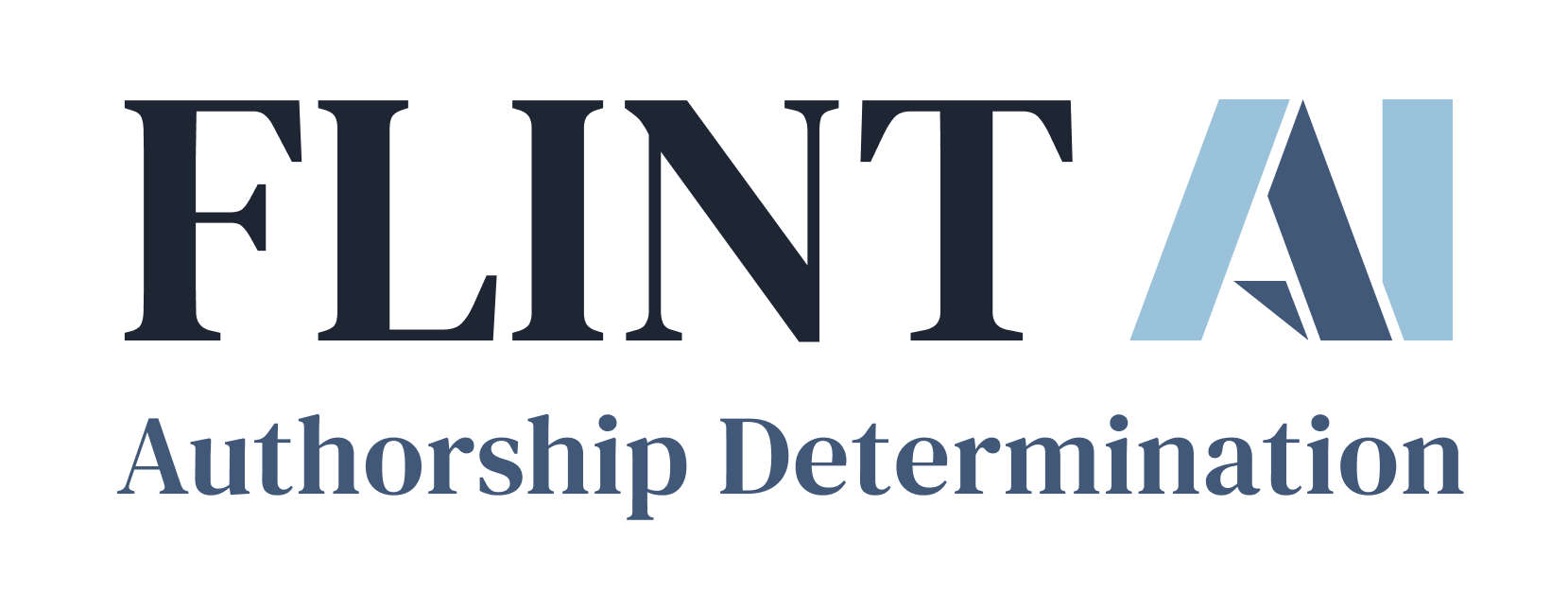Automatically analyze documents for authorship attribution, contract cheating, plagiarism detection, demographic profiling, and threat assessment.
The Flint Software System was developed to enable businesses to analyze whether a certain document of questioned origin shares likely common authorship features with other documents of known origin applying standard linguistic rules and patterns.
New challenges such as ChatGPT and other Generative AI tools are creating a near impossible environment to stay on top of and manage.
The evaluated features include linguistic phenomena of various kinds, including grammatical patterns, punctuation and word usage. Statistical analysis is then applied to evaluate the features, applying weighted values that are determined by the commonality and rarity of each feature. The more rare the feature, the more value that is associated with it, suggesting higher likelihood of unique document identification and commonality. Linguistic fingerprints are created that are unique for each author and for the documents at question. These are compared to each other. As in any statistical analysis, the reported results are not conclusive. Rather the analysis reports the likelihood of a conclusion.
Automated & Efficient
Our software is a fully automated solution, which will help you dramatically reduce costs required for running custom analysis.
Flexible & Adaptable
The user can control key variables to ensure that the analysis fits the particular goals for individual use cases.
Confidence Intervals
In addition to providing an answer, FLINT AI software will provide confidence intervals, so you can have a realistic understanding of authorship probability.

Authorship Attribution
Authorship Attribution will help to determine authorship of certain documents, where the author is unknown. Authorship Attribution will compare language patterns from source documents, consisting of documents authored by suspect authors, to the documents at question. The results will confirm or reject hypotheses of common authorship (e.g. did the suspect write the ransom note?). The FLINT software provides a method and tool to automate the examination of a large number of documents in a short amount of time, and provide fully transparent empirical results with probabilistic assessment of authorship.
Question:
Who is the author of a given document? The user has a pool of suspects whom they believe might have authored the document at question.
Input:
Documents of which the authors are known. Multiple documents from each suspect author are uploaded into the FLINT system.
Process:
FLINT will perform a linguistic analysis comparing the document at question with documents authored by the group of individuals, one of whom is thought to have authored the document at question, running a statistical analysis to determine which of the known authors is the most likely to have authored the document at question.
Output:
Report determining which of the authors of the input documents are likely to have authored the document at question, indicating a level of certainty associated with each author.


Authorship & Contract Cheating
The Contract Cheating version of Flint's software enables the detection of whether the claimed author indeed authored the document, or whether it was authored by someone else.
Input:
Documents which are known to have been authored by the author along with the document(s) in question.
Process:
FLINT will perform a linguistic analysis comparing the document at question with the group of documents provided as Input, running a statistical analysis to determine whether or not the alleged author indeed authored the given document
Output:
Report determining whether or not the alleged author is the author of the alleged document, indicating a level of certainty associated with authorship
Plagiarism & Forgery
The Plagiarism & Forgery version of Flint's Software enables the detection of (i) plagiarism, i.e. whether or not the known author of a known document copied text without authorization from the author of other documents, passing the document as their own work, and (ii) forgery, i.e. whether or not the alleged author of a known document indeed wrote the document at question.
Question:
Who is the actual author of a given document? The user has a document with an alleged author, and the question is whether they indeed authored the document, or whether it was authored by someone else.
Input:
Documents which have been authored by the alleged author.
Process:
FLINT will perform a linguistic analysis comparing the document at question with the group of documents provided as Input, running a statistical analysis to determine whether or not the alleged author indeed authored the given document
Output:
Report determining whether or not the alleged author is the author of the alleged document, indicating a level of certainty associated with authorship


Demographic Profiling
The Profiling version of Flint's software enables the identification of the background of the known author of a document, including their nationality; native language; occupation; training; education; past residences; age; experience; workgroup and individual identity.
Question:
What is the background of the author of a given document? Where are they from? What is their occupation and education?
Input:
Linguistic rules, grammar usage and known idio-synchratic language usage
Process:
FLINT will perform a linguistic analysis comparing the document at question with the background of different social groups, creating a linguistic fingerprint that is unique for the authors, comparing these to the linguistic fingerprint of the document at question and running a statistical analysis to determine the requested background of the given author, to evaluate native Language, native dialect, age, gender, occupation, education, etc.
Output:
Report determining the background of the author, indicating a level of certainty associated with background
Threat Assessment
The Threat Assessment version of Flint's software assesses the level of risk associated with a given threat, the likelihood of the threatened behavior being carried out.
Question:
What is the likelihood that a threat expressed in a certain communication will be executed upon.
Input:
Document with an unknown author contains a given threat.
Process:
FLINT will perform a linguistic analysis of the document at question, comparing to groups of prior threats, and which of those the threat was executed upon, creating a linguistic fingerprint that is unique for the authors, comparing these to the linguistic fingerprint of the document at question and running a statistical analysis of likelihood that the threat will be acted upon, based upon language used in the document at question.
Output:
Report determining the likelihood of threat execution, indicating a level of certainty associated therewith.

